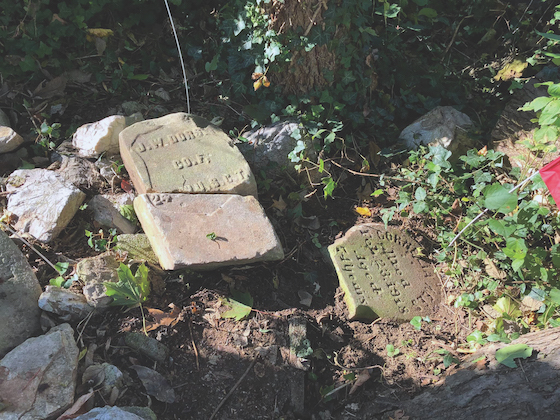Neither Gone Nor Forgotten

After being razed, Halfway Cemetery was neglected for decades. Today, Hood faculty, students and community volunteers are tackling identification and cleanup of this lost African American burial ground near Hagerstown, Maryland. We talked with David Hixson, Ph.D., visiting assistant professor of art and archaeology, and James Locke ’23, president of Hood’s student archaeology club about their efforts.
Reclaiming and Restoring a Historic African American Cemetery
Program
- Art & Archaeology, Archaeology Concentration (B.A.)
Department
- Art & Archaeology
What is Halfway Cemetery, and what is the work you are doing?
JL: Halfway Cemetery, or what remains of it, is an African American cemetery that has fallen into despondency. Its earliest burial is believed to be Jesse Guynn, dating back to 1844. The cemetery is host to a wide array of 19th to 20th century burial remains and cemetery artifacts. A collection of headstones and funerary markers cover what remains of the divided land. Our project deals with only a small portion of the cemetery, as the rest of the cemetery was built upon with modern homes, property lines and fences. The developer’s apparent disregard for human remains and their innumerable self-serving disturbance of archaeological remains in the area is typical of the destruction of African American cemeteries across the United States. According to Emilie Amt, Ph.D., professor emerita, more than a hundred burials have been recorded at Halfway.
How did the project evolve?
DH: This project began with Elizabeth Paul, a landowner in the Halfway neighborhood who began to research her property. She had what appeared to be an abandoned lot adjacent to her backyard, and she had heard it might have once been an African American cemetery. She reached out to Dr. Amt. To their surprise, this parcel was the historic Halfway “Colored” Cemetery that Dr. Amt had been looking for in her research. Dr. Amt had believed that this cemetery was completely obliterated by the mid-20th century development in which Elizabeth Paul lived. In fact, a small reserve had been left at the heart of the burial grounds, now abandoned and all-but-forgotten.
Why is the work important?
DH: The history of the United States has many intentional gaps created by willful ignorance regarding racial injustice. This cemetery was not moved to make way for a white neighborhood; it was quietly destroyed. Few homeowners even know that their land was once sacred ground for the local African American communities of the Hagerstown area. Such painful gaps in our history need to be filled as best we can. Our efforts will not provide justice for the disinterred and their descendants, but it is one step towards healing the wounds that rest (quite literally) just under the surface of our nation.
How common is it for cemeteries to be hidden in plain sight?
DH: Unfortunately, African American cemeteries (along with some cemeteries of the poor or indigents) were often “unmarked.” By this, we mean that the dead did not receive a permanent carved stone monument. Such graveyards rarely entered the historic record and eventually became lost (or ignored) by later generations. But the Halfway Cemetery appears to have had well-marked graves with carved stones. Its partial destruction was willful. Only the heart of the graveyard was set aside for preservation, locked outside of public view or access by surrounding it with fenced homes.
How is technology being used to restore the cemetery?
DH: We are in the process of mapping the cemetery, both the reserved section and what may remain beneath the lawns of neighboring backyards. We have so far implemented ground penetrating radar, electrical conductivity and magnetometry, all graciously provided by Ohio Valley Archaeology, Inc. and Jarrod Burks, Ph.D. Furthermore, our Hood Archaeology Club will be spending weekends plotting the locations and alignments of the few remaining headstones and footstones within the cemetery reserve to reconstruct the locations of intact graves as best we can. Finally, we will be mapping the results of all techniques on a 3D map of the area created by drone photogrammetry, a specialty of mine.
James, what has been the biggest takeaway for you, and has this work influenced what type of career you’ll pursue after you graduate?
JL: As for the takeaways from this project, I view it as a sort of moral obligation to those buried in this forgotten cemetery. I’m sure my colleagues share the same sentiment. The opportunity to help document and preserve the history of those buried at Halfway is one that provides both archaeological experience to my fellow colleagues and peace of mind to the descendants of those buried in the cemetery. In terms of how this project has impacted my career and future aspirations, since helping with the cleanup I have been permitted a glimpse into both our country’s real history and a look into the impact an archaeologist can make. I hope to enroll in grad school following Hood.
What will happen once the cleanup is completed?
DH: The intent is to demonstrate an ongoing and continuing care for the graveyard, allowing for a permanent, recognized easement to protect the property from further encroachment or destruction. Outreach to descendant communities is ongoing with the hope of putting together a long-lasting coalition of volunteers to maintain the property in perpetuity. Our archaeology student club is not the only organization supporting this effort. The Boy Scouts, the Daughters of the American Revolution and Visit Hagerstown have graciously donated their time and funds. Anyone and everyone is welcomed to help. For more information, visit the “Friends of Halfway MD African American Cemetery” Facebook page.
Are you ready to say Hello?
Choose a Pathway
Information will vary based on program level. Select a path to find the information you're looking for!
